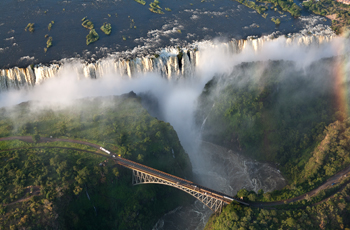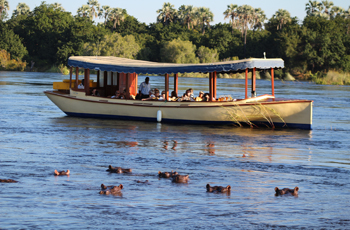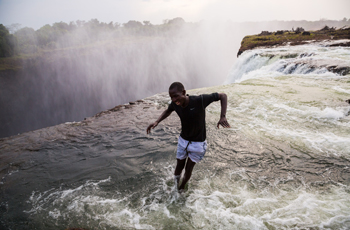Best Time to Visit Victoria Falls

Victoria Falls is situated at the border between the countries of Zimbabwe and Zambia and it is conveniently located within 100-kilometres of Botswana and Namibia too. A visit to ‘Vic Falls’ is an essential inclusion in your Southern Africa safari itinerary. During the flood season, spray from the falls created by the mighty Zambezi River pouring into the gorge rises up to 400 metres into the air. The plume can be seen from up to 48 kilometres away and confirms the aptness of Victoria Falls’ indigenous Tsonga name Mosi-oa-Tunya, ‘The Smoke That Thunders’.
Victoria Falls experiences hot summer conditions from September to April and a mild winter from May to August. Rainfall occurs in the later summer months (December to March) with little to no rain between May and September. Where the beginning of summer is hot and dry, once the rains start, it becomes hot and humid. Temperatures over 30°C are common. In winter, temperature highs in the 20s are normal with the mercury dropping into single digits at night. The best time to visit the falls really depends on the activities that interest you. From seeing the falls to game drives, bird watching, river rafting, guided hikes, helicopter and microlight flights, elephant-back safaris, and cultural experiences, you are spoilt for choice. Between April and June the volume of water flowing over the falls is at its highest level. Visitors get drenched by the spray and views of the falls can be obscured. But, this is the best time to view the full glory of the falls and the spray plume from the air. From June to November the amount of water going over the falls dwindles and the falls change to separate from a full-width torrent into a number of individual cascades. This is the ideal time to view the spectacular detail of the rocky cliff face normally shielded by the veil of water even if the falls themselves are a little below expectation.

Experience the Victoria Falls
The falls can be experienced from national parks on both the Zambian and Zimbabwean sides.
Mosi-Oa-Tunya National Park in Zambia offers a circular self-drive route, much of it alongside the river. Visitors may opt for a guided game drive or guided walk. With few predators in the park, the animals are quite relaxed providing some superb photographic opportunities. Bird watchers will appreciate an impressive array of birdlife. The rare Taita falcon is one of 35 species of raptors that breed in the falls section of the park.


A number of walking paths lead to various viewpoints of the falls but be sure to wrap your technological gadgets in a plastic bag to protect them from the drenching spray. Take the path upstream - with great care – to see the Zambezi River as it approaches the rim of the falls. The walk across the narrow footbridge to ‘Knife’s Edge’ will reward you with a view of the Eastern Cataract which has its best flow in late summer. The route to the ‘Boiling Pot’ is a more strenuous walk as it is accessed by a steep path into the gorge. At high water this deep pool features enormous, slow swirls and heavy boiling turbulence. The walk out of the gorge, back up this steep trail, is an experience! Victoria Falls National Park in Zimbabwe offers the best view of the Main Falls and Devil’s Cataract. A beautiful rainforest-like ecosystem thrives here, sustained by the spray from the falls. Visitors can explore the rainforest on various pathways that lead to the Livingstone Statue and a number of scenic viewpoints. The rainforest supports a diversity of plant species, birds and small mammals.
Zambezi National Park, also on the Zimbabwean side, is located on the Zambezi River upstream of the falls. This park offers excellent game viewing with elephant, lion, buffalo, leopard and hippo as well as herds of sable and eland antelope. Keen birders will appreciate the presence of the near-threatened African Skimmer which spends July to November on the sand banks of the Zambezi to breed. Game usually concentrates along the river during the dry season and disperses as soon as the summer rains begin around November or December. Victoria Falls National Park offers lunar rainbow tours each month on the day before, the day of and the day after a full moon. On these evenings, you may have the pleasure of observing a ‘moonbow’ or lunar rainbow. It is created when moonlight refracts off the water droplets in the spray and Victoria Falls is one of the few places in the world where you can witness this rarely-seen phenomenon. The colours, usually less intense than a sunlight rainbow, are best captured with long exposure photography. The moonbow is best seen between April and July when the falls experience their heaviest flow.
When Best to Experience the many Activities at Victoria Falls
The Livingstone Island and Devil’s Pool Tour is a sensational way to experience Victoria Falls. Between early July to early March, when the level of water in the river is low, a short but exhilarating boat ride - departing from the Royal Livingstone Hotel - speeds across the Zambezi River to Livingstone Island. Located mid-river, it offers a jaw-dropping view of Horseshoe and Rainbow Falls. Between September and December, those feeling brave enough can jump into Devil’s Pool, a natural ‘infinity pool’ with minimal current near the edge of the falls. Protected from going over the falls by a natural rock barrier, one can lie in the relatively still water and look over the edge into the gorge - 108-metres down! It is a heart-pounding experience that you will never forget.
The best time for Whitewater rafting is from August to December, as the high water subsides and the upper rapids are opened for you to enjoy. Starting below the falls at Rapid 1, this is an exhilarating experience. In the high water season (Jan-Feb and June-July), rafting starts further downstream at ‘Overland Truck-eater’ (Rapid 11) and runs to ‘The End’ (Rapid 24).
For keen bird watchers, migrant birds arrive in September for the summer so the summer months will be best for birding. The start of summer - late August until the first rains in November - is ideal for game viewing. Sparse vegetation increases game spotting opportunities and, with less water inland, animals gather at the river.
The enormous scale of this formation is best viewed from the air. A helicopter flight, hot air balloon ride or microlight flip will provide a bird’s-eye view of the falls, the gorges, the Zambezi River and the adjacent rainforest areas. The Victoria Falls area offers a tantalising menu of adventure activities. Bungee jump from the bridge, dare to gorge swing, abseil down the sheer-rock face of the gorge or experience the delight of white water rafting, river boarding or jet boating on the rapids of the Zambezi River.
More sedate pursuits include a visit to the vibrant Livingstone Craft Market, canoeing on the calm waters upstream of the falls or leisurely sunset cruises, elephant or horseback safaris, tours of the Victoria Falls Bridge, and high tea on Stanley’s Terrace at the Victoria Falls Hotel. Or head to The Bridge Café and sample a Bungee Burger and a Zambezi Lager while watching bungee jumpers launch themselves off the bridge!

The town of Victoria Falls, on the Zimbabwe side, is a tourist hub with accommodation options, bars, restaurants and cafes, supermarkets, and an airport. A range of arts and crafts are available from street vendors while boutique-style shops and galleries can be found in the town. The town of Vic Falls, as it is locally known, also hosts annual events such as the Victoria Falls Marathon and the Vic Falls Carnival, a three-day music festival held over New Year. The town is small and can easily be walked.
Livingstone is the tourist epicentre on the Zambian side of Victoria Falls. It combines a genteel colonial character with an authentic African ambiance. Livingstone offers similar services and facilities to its Zimbabwean counterpart. The elegant Royal Livingstone Hotel is nestled beside the Zambezi River. They offer their guests an amazing excursion on the Royal Livingstone Express steam train. The four-hour tour passes through the Victoria Falls World Heritage Site where elephant and other wildlife can often be spotted. The train pauses for 20-30 minutes in the middle of the 112-year old Victoria Falls Bridge. Appreciate the sunset, explore the bridge, and enjoy a sundowners drink before a sumptuous five-course dinner is served on board the train.
Regional highlights are many, as Victoria Falls is centrally located with easy access to Botswana, Namibia, Zambia and Zimbabwe, be sure to include extra days to visit other locations. While experiencing the falls - from both the Zambian and Zimbabwean sides - is the focus and highlight of a trip to the area, both countries also offer other interesting sites.
In Zimbabwe, Hwange National Park (only 120-kilometres from the falls) is the largest park in Zimbabwe and it is home to 100 mammal and 400 bird species, including 19 large herbivore and eight large carnivore species.
In Zambia, the Lower Zambezi National Park is ideal for guided safari activities as well as boat-based safaris on the Zambezi River.
In Botswana, Chobe National Park is a must-visit location for elephant and game viewing. Riverboat and canoe safaris on the Chobe River are a highlight, while the famed Makgadikgadi Pans and the Okavango Delta are only a short light-aircraft flight away.
From Victoria Falls, take a few days to explore the treasures of northern Namibia including Etosha National Park, the Kavango River and the Caprivi Strip.
African Travel Gateway can assist you with information about the necessary visa requirements for both Zambia and Zimbabwe and neighbouring countries. We’ll help you to plan an incredible Victoria Falls adventure.




